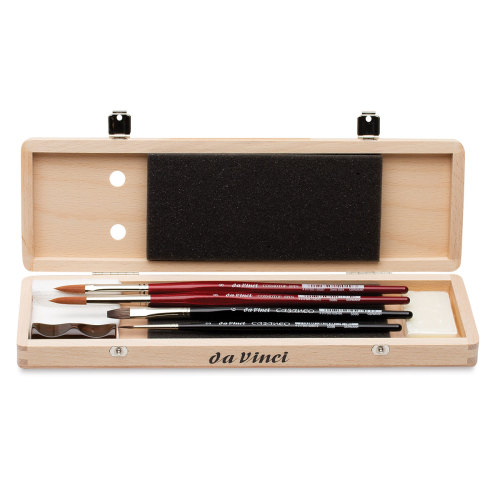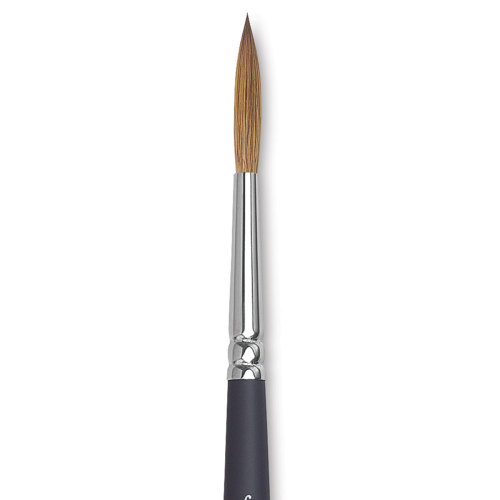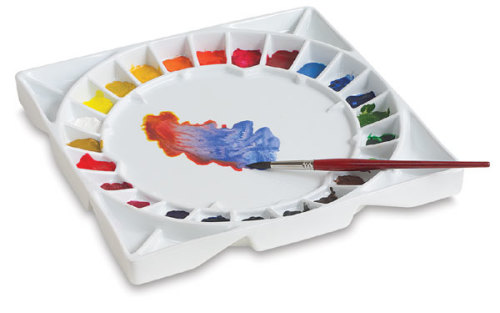Gouache vs watercolour, what’s the difference? They are two popular mediums that artists use worldwide to create both professional and sketchbook work. The ingredients in the paint are quite similar, but there are noticeable differences in the way they perform.
In this guide, find out how to paint with watercolour and gouache, with a look at the different techniques and supplies needed.
Find answers to all the questions you might have about the gouache and watercolour to help you decide which medium to get. Leave us a comment if you have any other questions!
Disclaimer: Fine Art Tutorials is a reader supported site. When you make purchases through links on this site, we may earn a small commission at no extra cost to you.
The main differences of watercolour and gouache summarised

The main difference between watercolour and gouache is the transparency of the paint. Watercolour is a naturally transparent medium, whereas gouache is opaque. This difference in opacity leads to artists layering paint differently, using different techniques and ultimately creating different effects. Titanium white, which is a completely opaque pigment, is available as a gouache paint colour, whereas you can’t get white watercolour paint.
What effects can you achieve with gouache vs watercolour?
Finished watercolour paintings have a unique appearance. The features are often delicate and light. Because paint is so transparent, it takes layers to make areas appear dark. Build multiple layers of watercolour to achieve a rich pigmented appearance. Watercolour has a lower viscosity than gouache and artists tend to use more water to thin the paint. Therefore, the result is sheer washes, that use the brightness of the paper beneath to resemble passages of light.
Artists use gouache to create flat, opaque blocks of solid colour. Illustrators and designers who want vibrant and intense colours straight from the tube to create characters, surface pattern designs and illustrations, favour its ability to create solid colours. The gouache medium is also favoured by fine artists. Artists can opt to add a tiny bit of water to gouache to create a thick, creamy consistency and optimum opacity, or to use more water to create semi transparent layers.
What is the painting process for watercolour vs gouache?

Generally the painting process for watercolour involves painting light to dark. Leave the brightest highlights free from paint and gradually increase the darkness of midtones and shadows with layers of watercolour. In the watercolour portrait pictured above, the brightest highlights are in the silver earrings. These highlights were left free from paint, except from the subtle reflections of the hair at the bottom, to give the appearance of the metal catching light.
With gouache, there is a flexibility to paint dark to light if the artist chooses. Because paints are opaque, artists are free to paint mid-tone colours, then increase the lightness of areas by combining colours with white. Titanium white is opaque, so artists use this pigment to create tints, leaving the brightest highlights until last. Gouache paint has the ability to correct mistakes and clean up areas that need adjusting. You can use gouache paint for tiny highlights and details over watercolour paints too.
What’s the difference between gouache and acrylic?
Gouache is slightly thicker and more opaque than watercolour, so you may be thinking that this sounds similar to acrylic. Acrylic is different, however, in that it is not re-wettable when dry. Gouache and watercolour are both re-wettable when dry; lift dry paint, or work into it for days at a time. Artists can get acrylic gouache paint, which is waterproof when dry similar to acrylic, but has a matte finish, similar to gouache. This can be used to create final waterproof layers in a gouache painting.
Gouache vs watercolour: What is the paint made from?

Gouache and watercolour paints have similar contents. They are both made from pigment and a binder with the main ingredient being gum arabic. Gum arabic is a water soluble binder that is also soluble once dry.
Manufacturers of professional grade watercolour brands will make paint with lightfast pigments. This gives the colours high permanence ratings. The better the lightfast rating, the less likely the paint colour is to fade over time with exposure to UV. There are lots of options when it comes to professional, lightfast watercolours but fewer options when it comes to professional permanent gouache. M. Graham, Schmincke or Holbein are perhaps the best quality gouache paints when permanence is taken into consideration.
In professional quality watercolour paints, additives like honey are mixed into colours to make application smoother and the colours appear more bright. M. Graham uses honey in their gouache paint, which has the added benefit of preventing cracking.
The opacity of artist quality gouache is made by increasing pigment content in paint tubes. This is true for M. Graham, Schmicnke, Holbein and Winsor & Newton. Some student quality brands may add inert materials like chalk to increase opacity. However, this can have an adverse effect on the quality of the paint and the finished look of the painting.
Advantages and disadvantages of gouache vs watercolour
The advantages and disadvantages of watercolour and gouache are similar but not the same. Discover which type of paint would work best for your style and preferences with this pros and cons list.
Gouache advantages
- Gouache is a versatile paint that is water soluble. Thin with more water to achieve semi transparent washes, or less water to paint with thick, cream like colours.
- It’s so easy to clean! Simply wash brushes and palettes with water, or if you want to go the extra mile, use some brush soap.
- Gouache is quick to set up and clean away, this makes it especially appealing for artists wanting to create sketches and paintings en plein air.
- You don’t need many materials to create a gouache painting, making it especially portable and cheap to get started with.
- Paint is safe compared to other mediums. Look out for colours with cadmium or cobalt in them, as these pigments are toxic. Apart from that, paint is safe to use in the studio, classroom and to take travelling.
- Artist grade paints are vibrant and can be layered beautifully to create a variety of brush marks and effects.
- Gouache is bright and matte in appearance, which makes it suitable for photographs and scans. Designers and illustrators use gouache to create pieces to reproduce and distribute as art prints or designs.
- It’s a forgiving medium that can be corrected easily. To correct a mistake, paint over with an opaque colour. Or lift the previous colour with water, wait for it to dry then paint over.
- Gouache can be used with watercolour materials and techniques, making it an incredibly accessible medium.
Gouache disadvantages
- Colours can change in value from wet to dry. Generally, light colours dry to become lighter.
- Paint film is brittle when dry, so if painted on flexible surfaces like canvas, the film could be more prone to cracking. Combat this by using a high quality gouache paint like M. Graham, that mixes their colours with honey to make the paint film more stable. Also, make sure to paint on a quality watercolour paper.
- Paints are fast drying, which makes blending tricky. To blend into a dry colour you will need to add more water.
- Paint film is not water resistant when dry. Finished artworks should be protected from moisture and UV by framing behind UV glass.
Watercolour advantages
- Watercolour is easy to clean up, set up, pack away and take on trips.
- There is a huge variety of paint brands to choose between and paint is much less expensive than oil or acrylic.
- The experience of painting with watercolour is incredibly fulfilling and different to any other medium, it requires planning and patience but encourages creativity. Artists never feel completely in control of the water when it is swirling across the paper, but the art is in harnessing the properties of the paint and the fun is in letting go and allowing the watercolour to work its magic. This same experience cannot be felt using gouache, oil or pencil.
- Paint is vibrant, but also light and transparent. Some colours will granulate, providing wonderful texture.
- Use the transparency to create delicate glazes and washes. Watercolour has a particular light aesthetic that is difficult to achieve with any other medium.
- It is a safe and non toxic medium, as long as you don’t buy pigments such as cobalt and cadmium.
Watercolour disadvantages
- It is less versatile than mediums like oil or acrylic. You need an absorbent surface to hold multiple washes of colour, otherwise paper can buckle. To prevent paper from buckling, stretch the paper first.
- Mistakes are hard to correct with watercolour. There is an element of foreplanning involved in working out where the highlights will be and leaving the paper to shine through in these areas. In this sense, it is a less spontaneous medium than gouache. Use masking tape or fluid to reserve areas that you want to keep lighter.
- Watercolour techniques are more difficult to master than gouache.
Is gouache or watercolour better for beginners?
Watercolour can be a tricky medium to master, but don’t let that put you off! If you’re looking for a medium that is easier to learn and master go for gouache. Because of the way gouache paint can be layered dark to light and highlights added last, some of the painting skills and techniques are transferable to other mediums like oil and acrylic too.
Both mediums are studio safe, budget friendly and easy to clean. If you want a challenge and love the transparent effects that can be achieved with watercolour, have a go at learning watercolour. However, if you like the way that opaque colours can be layered with gouache and its forgiving nature, have a read of our gouache for beginners guide to get started.
Can you use gouache and watercolour together?
Watercolour and gouache work together beautifully and many professional artists use them together. This is because the mediums essentially are made from the same materials; gouache is like an opaque watercolour.

Use white gouache as the final highlights in a watercolour painting, to save yourself from using masking fluid. For example, you could paint a galaxy scene, then use white gouache to dot tiny bright stars across space.
Another way to use the two mediums in conjunction, is to use watercolour as glazes. Thin the paint with water and layer it over gouache or watercolour. The glaze will act as a transparent film of colour which will alter previous layers, to darken shadows, increase contrast, alter colour temperature or hue.
Gouache and watercolour mixed media

Both watercolour and gouache work excellently in mixed media artworks. Layer soft pastel or oil pastel over the top of the two mediums to create intensely pigmented, vibrant marks.
Use pencil and ink with either medium. Watercolour pencils work especially well with gouache and watercolour. Create your drawing under your gouache piece with a watercolour pencil; the water will dissolve excess pencil marks. Or use the watercolour pencil to create fine details on top of your painting.
Paint with acrylic or acrylic gouache over the top of watercolour or gouache paintings. Oil and watercolour can be used together to create a resist, as oil is hydrophobic it will resist watercolour washes.
Do professional artists use gouache?
Professional artists have been using gouache since its inception. Brands such as M. Graham make professional quality, lightfast paints that artists can use to create vibrant, saleable works that stand the test of time.
What are the best brands of gouache?
M. Graham, Schmincke and Holbein are brands that manufacture the best quality gouache paint. Winsor & Newton is another great brand that is slightly cheaper and more widely available and therefore slightly more accessible for beginners. Each of these brands increases the opacity of gouache with pigment content instead of bulking the paint out with chalk. When using the likes of M. Graham or Schmincke, you can be sure that the brands have used the best quality pigment and binder possible. Check the paint tubes for pigment information to find out about the permanence of individual colours if saleability is a concern for you.
What are the best brands of watercolour?
There are numerous brands that make professional quality watercolour paint. Schmicnke use only the most lightfast pigments, with maximum pigment load and come in pan or tube formats. M. Graham binds their paints with the finest gum arabic and honey to create 70 luxurious colours. Daniel Smith makes 250 wonderful colours, with safe cadmium alternatives and a range of mineral pigment paints.
The best supplies for watercolour vs gouache
The supplies used for watercolour and gouache are interchangeable. Soft brushes, watercolour paper, paint and water is all you need!

Synthetic watercolour brushes have more of a spring to them than natural hair brushes and the fibres are also slightly less absorbent. Gouache is thick in consistency compared to watercolour, so you will need a springier gouache brush to move the paint across the paper.

Sable brushes are a favourite choice amongst artists for watercolour painting. They are soft, taper to a point, but have enough elasticity to snap into place as the brush is dragged across the paper. If you don’t use animal products, or want to avoid the large price tag that comes with a kolinsky sable brush, synthetics are a great alternative. You can also get some great travel watercolour brushes for painting plein air.
Thick cotton watercolour paper works brilliantly with both watercolour and gouache. Paper that has a weight of 90lb or higher will be thick and stable enough to absorb washes. These Strathmore sketchbooks are excellent, with thick 140lb paper and in a large 9×12” size, they would make a great accompaniment to art class.

Plastic and ceramic palettes are great for both mediums. Plastic palettes are light and easy to transport. Mijello makes a sealable plastic palette that artists can take to paint on location. Ceramic palettes are more suited to studio work. They’re heavy weight so won’t move around on the table, they are also stain resistant and easy to clean.
What techniques can you use with gouache vs watercolour?

Similar techniques can be used with both watercolour and gouache. Create flat washes by adding a little water to the paint and creating a solid, even colour on the paper. This is a basic technique useful for larger areas of a painting, for example the sky colour.
Blending can be achieved by either painting wet on wet, this is the most effective blending method where colours will mix together on the paper. To blend dry colours, dampen your brush and work the second colour into the paper.
Another great technique to use with either gouache or watercolour is the dry brush technique. Create the appearance of texture by dipping your brush in some colour, then removing excess residue and liquid from the brush. Then brush over the paper to create your desired texture. The resulting marks will appear broken and organic looking. This is perfect for creating the effect of leaves on a tree with a few short sweeping marks. This technique works best on rough or cold pressed watercolour paper, as the dry paint will emphasise the outcrops of the paper texture. As the aim of dry brushing is to impart as little of the paint as possible, it shouldn’t settle into the crevices of the paper.
Gouache and watercolour painting ideas
Paint a watercolour landscape
Create a simple landscape using only a few colours and one brush. Sketch out the scene first with a pencil or watercolour pencil, then wet the paper and start painting! Karen Rice uses Prussian Blue for the sky with Mijello watercolours. The artist uses a size 14 Escoda brush, that holds a lot of water but tapers to a point.
If you want to follow a comprehensive watercolour course, take this master class on Skillshare where Zaneena Nabeel will teach you how to paint foreground and background elements, how to mix colours and walk you through the process of painting four different landscapes. For more watercolour painting ideas, check out our guide!
Paint a coastal landscape with gouache
For this coastal gouache landscape, I used cold pressed paper which helps with emulating the effect of texture and detail in the clouds and grass when using the dry brush technique. I used gouache colours by Winsor & Newton, plus their opaque titanium white to mix into the final layer of the painting to achieve the bright, contrast in the details. Check out our guide on how to paint a landscape with gouache for more tips!
Paint a still life with gouache
Paint juicy looking orange slices, with luminous colours. This artist uses a range of professional quality paints, including colours from M. Graham and Winsor & Newton.
Take this class on Skillshare taught by Cécile Yadro and learn to paint a beautiful still life set up with gouache. Paint colourful fruit and apply the skills to creating your very own still life, from making the arrangement to laying down the final details. Check out our guide for more gouache painting ideas.
If you’ve found anything on this site especially useful, you can make a donation to me through PayPal. I take a lot of time to research and write each topic, making sure each tutorial is as detailed as possible and I make all my content freely available. Any small donation (even the price of a cup of coffee!) can help me to cover the running costs of the site. Any help from my readers is much appreciated :).
Follow the link in the button below to support this site.


Excellent information for all not just beginners!!
Thank you so much!
Kathy